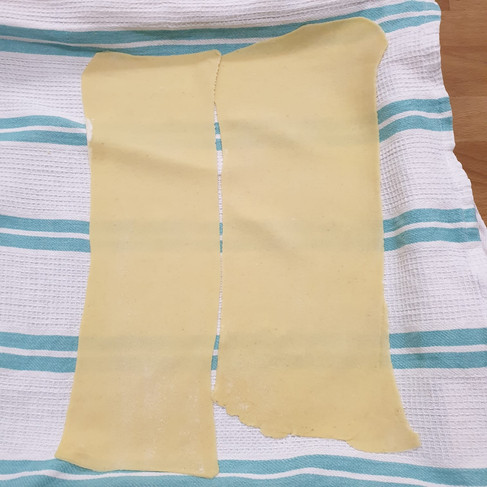LASAGNE alla BOLOGNESE
- Maria-Lucrezia

- Mar 1, 2021
- 3 min read
Updated: Jun 13, 2023

The crispy crust that peels away from the sides of the dish, the sweet aroma of the meat sauce mixed with the béchamel that comes out of the oven: lasagne is undoubtedly the main dish on the Italian Sunday tables.
Today's recipe follows the classic Lasagne alla Bolognese, typically from Emilia, but each region of Italy has its own version: in the South we make it with lots of tomato sauce and mozzarella, in Naples with meatballs and boiled eggs... I'll stop now because I could go on forever.
The best thing about lasagne? You can create your own version, adding ingredients, removing what you don't like and, of course, you can make it vegetarian or lactose free.
According to the original recipe, the dish is created from the union of 3 ingredients that are prepared at home:
- fresh egg pasta
- bolognese meat ragù
- béchamel sauce
INGREDIENTS PREPARATION: 4 h / SERVING SIZE: 6 persons (for a baking tray of 30×22 cm)
Fresh Lasagna
200 g of wheat flour 405
200 g of durum wheat semolina
2 eggs
water
Ragù Bolognese
300 g of coarsely chopped beef
150 g pork belly
1 large carrot ( approx. 50 gr)
1 piece of celery ( approx. 50 gr)
1 onion ( approx. 50 gr)
300 g of tomato puree or peeled tomatoes
half a glass of dry white wine
olive oil (2 spoons)
salt and pepper
Béchamel sauce
100 g grams of flour 405 or 550
100 g of butter
1 l of fresh whole milk
salt and nutmeg
Assembly
250 g of Parmigiano Reggiano Dop or Grana Padano Dop
DIRECTIONS
Ragù sauce
I recommend starting with the Bolognese sauce, because as my grandmother used to say, the longer you let it cook, the better.
Chop the vegetables and the bacon into small pieces. Brown the pork belly in a pan with oil over a low heat. Add the chopped vegetables and cook for at least 10 minutes. Add the minced beef and let it blanch.
Deglaze with the wine and, when it has evaporated, add the tomato sauce; leave to cook for at least 2 hours, stirring and checking from time to time and keeping the lid on the pot tightly closed. Add salt and pepper at the end.
Béchamel sauce
Put the butter in a pan and let it melt over low heat, then add the flour and mix for 2-3 minutes; add the hot milk and mix with a whisk until you see the béchamel thicken.
Combine the grated nutmeg and salt, then turn off the heat. If you do not use the béchamel immediately, cover it, otherwise it will develop a consistent crust.

Fresh lasagna
Mix the flour and water and knead by stretching and folding for few minutes until you create a mix that feels smooth like a playdough. Cover the dough and let it sit for 15-30 min. Alternatively, you can store it in the fridge up to 3 or 4 days or up to several months in the freezer.
Roll out the pasta dough in sheets (thin enough that the light passes through) using a pasta machine or a rolling pin. The number and size of the sheets depends on your pan, for a baking tray of 30×22 cm I would recommend 10 sheets of 20x15 cm. This way you'll end up having 5 layers (in my opinion, layers are never enough!)
ASSEMBLING
Start spreading some béchamel sauce on the bottom of the try, then lay the sheets next to each other. Place the béchamel sauce, the ragù sauce and the grated Parmigiano Reggiano on top of the sheets.
Make up the other layers in the same way (at least 6-7 in total) and cover the last layer with meat sauce mixed with béchamel sauce, sprinkled with grated Parmesan cheese. It is very important to cover well the last layer of pasta, otherwise it will dry out in the oven!
COOKING
Bake the lasagna in a static oven preheated to 180° for about 45 minutes (last 5 minutes with grill function on); before serving, let it rest for at least half an hour, so that it can settle and cut better.

TIPS
Keep the pasta cover. Pasta dries out surprisingly quickly if left uncovered, which makes it difficult to work with and prone to tearing. Keep both the remaining pieces of dough and the rolled out sheets of pasta, covered with a piece of plastic wrap or a clean dish towel.
Once assembled, you can keep the lasagne raw for a day in the refrigerator or freeze it. Once cooked, however, I recommend eating them immediately or cutting them into slices and freezing them (allowing them to cool completely first).
Buon appetito!




























Comments